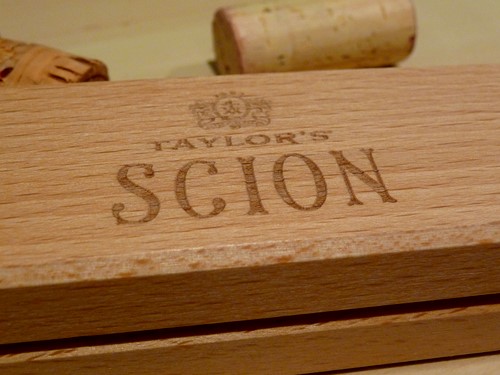
A great privilege to be able to try this tawny Port, dating back to the 1850s. Taylor’s have acquired two pipes of it (a pipe is 600 litres, but with an older wine like this the barrels won’t be full), and are releasing it this December, at a price tag of £2500 a bottle. It’s a lot of money, but this is so old it’s pre-Phylloxera. It’s a bit of history.
The sample I was sent was interesting. A test-tube containing a tasting measure, in a special wooden box. With oxidative wines such as tawny you can do this – it wouldn’t work with normal table wines.
Taylor’s Scion Tawny Port
Slightly murky brown with a paler, yellowish rim. Really complex warm, spicy nose with notes of old furniture, casks, crystalline fruits, raisins and tar. Concentrated, dense palate with warm, spicy, nutty flavours and really high acidity. Everything has concentrated up through the long ageing process, including the acidity, which helps keep this lively and spicy, with an eternal finish. Brilliant stuff. 96/100

Interesting read Jamie.
What’s so special though about the wooden box?
Thanks
Joe
I am EXTREMELY envious of your opportunity to taste this!
These sampling tubes are a very good idea. Why do you not think that they would work with table wines? I would have thought that, with careful handling, oxygen exposure could be controlled perfectly well.
I’m gobsmacked!
I’ve seen table wine in test tubes at liwf, seemed a fun idea.
The problem of these test tubes IMHO is that the amount os too small for serious tasting. It’s really a single glass while there’s no need to emphasise how crucial a wine’s evolution after opening is for proper assessment. IMO a reasonable amount to produce a serious tasting note and assessment is 150ml.
150cl, more like…
Jamie: maybe a stupid question but could you expand on your comment on the test tube measure: “with oxidative wines such as tawny you can do this – it would’nt work with table wines”? Is the wine in a reductive environment in a test tube or the opposite? I’m a little confused!
Because the level of oxygen pick-up involved in filling them might cause some damage. The environment isn’t terribly reductive because of the plastic caps. Unless they were filled in an inert environment, they’d likely take up close to a saturation of oxygen in the filling process.
If you could control oxygen pickup during filling, and double the volume, it would be great for sampling. Would save a lot of wasted wine and make it possible to send even expensive wines to wine writers.
I had the great privilege of trying the Scion as well and was amazed at the level of acidity and freshness it still retained amidst its molasses, raisined cloak. History in a bottle! You can get your hands on one for a mere £2500!
Sounds very, very interesting. Have just tasted the Millennium Port from 1880 from Nieport / Christiano van Zeller. Indeed thats a good port.
This Scion sounds also very good.
Is this a new trend ?